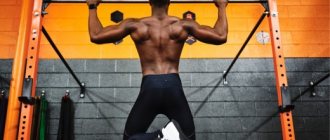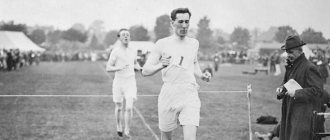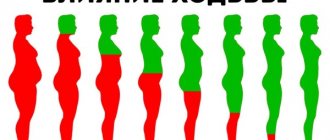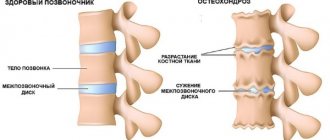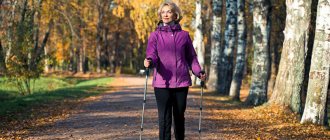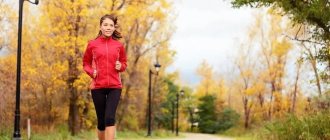What muscles work during Nordic walking?
Even distribution of the load during Finnish (as it is also called) walking allows you to activate and train all muscle groups equally.
The muscles of the cervico-brachial region, back, upper and lower extremities are strengthened and maintained in tone. People who have been walking for a long time notice an improvement in their figure. Correction of their posture is the result of active work of the muscles of the back and shoulders. The disappearance of the “breeches” or “ears” on the hips is a good workout for the thigh muscles. Reducing the abdomen - thanks to burning fat and tightening the abdominal muscles. Beautiful hands - because of the muscles of the hands trained with the help of sticks.
How to choose Nordic walking poles
Nordic walking poles are the only, but important, piece of equipment. If the poles are too long or short, pain will occur in the legs, back, and other parts of the body. But not only muscle pain, joint problems are also possible.
Therefore you need to know:
- When Nordic walking you need not ordinary ski poles, but poles specifically for this sport. They are lightweight and made of aluminum. They can be either fixed length or telescopic, in which the length can be set;
- There are straps on the handles of the poles that require special fingerless sports gloves. Thanks to this, you can push off the ground with poles when walking without squeezing the handle of the pole, which will protect your palms from calluses and abrasions. At the bottom of the stick there is a carbide knob, thanks to which you can easily push off from different surfaces when walking. If you walk on asphalt, you put on a special removable rubber knob;
- The choice of pole length depends on the person’s height. To do this, you need to multiply your height by 0.66. For example, with a height of 160 cm, 160x0.66=105. Thus, the length of the poles should be 105 cm.
Try this simple and effective sport and you will see that your body will be in perfect shape!
Newspaper “Voice of Cherepovets” Issue dated March 20, 2021
Nordic walking is gaining momentum in popularity, but there are some things that confuse beginners. It seems like you want to practice, but you are stopped by the lack of sticks or are tormented by fear: what if it doesn’t work out? And there is also embarrassment about age. Yes, yes, there is a stereotype that walking is only for pensioners. In this article we will dispel some myths and tell you how to prepare for your first classes.
Fizkultobed
Since our newspaper is one of the organizers of the Nordic Walking Festival (read on page 3), we approached the event with full responsibility and, as they say, started with ourselves.
The editor-in-chief of “The Voice…” Elena Bileva went to her first lesson, trading lunch for a workout, and the journalists talked with Nordic walking instructor Anna Beregova.
Our guide to the world of Nordic walking is a positive, smiling girl, in her every movement you can feel the energy and charge of health. Anna attended her first lesson as a student three years ago with Valentina Malkova.
I came across an advertisement on the Internet that training was taking place at the Metallurg stadium, came and... fell in love with walking - so to speak, from the first lesson. Having successfully mastered the technique, I decided to “get professional” in this amazing sport.
At first she became an assistant instructor, and after completing training courses, she became a mentor. Now Anna Beregova is a Nordic walking instructor at the MAU "Sports Club Cherepovets" and the Nordic walking club "Step by Step", as well as an official instructor of the Russian National Nordic Walking Association.
Walking suits all ages
What is the first thing that interests beginners? Of course, the general question is: who can walk?
“Nordic walking is also called a health technology for people of all ages and fitness levels,” answers
Anna .
“In fact, it can be done by everyone, from children to the elderly. There is a myth that Nordic walking is an active recreation activity only for pensioners. Actually this is not true. The origins of this movement were athletes. In the 1930s, Finnish ski coaches began to think about how to prepare their athletes in the off-season when there was no snow. As a result, they removed the skis and left the poles for training, in particular for running. At the competitions, Finnish athletes showed better results than their colleagues from other countries. It is worth adding that during Nordic walking, 90% of all muscles are involved. One session usually includes a 10-minute warm-up, 40 minutes of walking, and another 10 minutes of cool-down or stretching.
Don't take trekking ones
Second myth: Ski poles are suitable for walking. This is wrong! Choosing the right equipment is a whole science, and for the first lessons, Anna advises, it is better to come without your own poles, they will be given out at the club. Then the instructor will tell you how to choose the right poles and what length.
“I’ll say right away, if you walk with ski poles, then it’s just a walk with poles,” says Anna Beregova. — Many residents of our city walk with trekking poles - we call them “anti-sticks” for Nordic walking. Their main function is support, since they are designed for climbing or traveling, hiking in the mountains and plains with a backpack. Trekking poles have a massive handle and loop to keep the pole on your hand, but if something happens you can easily get rid of it.
Another disadvantage of this type of pole is its telescopic design. According to the instructor, many people believe that due to the adjustable length, such poles are suitable for the whole family, and this is another misconception. The telescopic mechanism will rotate over time. The greater the person's weight, the greater the load on the stick itself. The structure may simply collapse, causing injury.
One more nuance. “Anti-shock” - a built-in shock absorber - is not needed as a function, since the shock absorption is transferred to the elbow joint.
Correct sticks
There is a modified version of the poles - without a telescopic structure (fixed length) and with a lanyard instead of a regular loop. A lanyard is a kind of fingerless glove that provides a secure hold on the stick in your hand. Which is very important for practicing the correct walking technique!
It is better to consider a budget version of poles specifically for Nordic walking. What are their characteristics?
— Fixed length (according to height), — presence of a lanyard, — light weight, — curved tip (“tooth”), — and don’t forget about the rubber “boot” on the tip for walking on asphalt.
Those who have been walking for a long time take more expensive poles, which contain more carbon. It just lightens the weight of the stick. How to choose the length? In order to choose a stick by size, just use a simple formula. Multiply your height by a factor of 0.66 (for the health level, and for trained “Scandinavians” - 0.68), and you will get the desired length. In stores, fixed poles are sold in 5 cm increments, but don’t worry, the instructor can cut the pole to the desired length.
“Poles are such an individual thing that they are “adapted”, like shoes, to a person,” Anna Beregova concludes the conversation. “Today I told only basic things, but I hope that they will help Cherepovets residents choose equipment and not lose money on buying poles, which they will not be able to use later for health benefits. If in doubt, it is better to seek advice from an instructor.
We thank our instructor for the introductory lesson; in the next publication we will talk about the wise choice of clothes and shoes for walking.
Elena Molchanova,
newspaper "Voice of Cherepovets"
Nordic walking - exercise for weight loss in the fresh air
It allows you to increase the level of physical activity, thereby increasing energy expenditure, but at the same time does not overload the heart and musculoskeletal system, which is of enormous importance for people who are overweight.
Nordic walking - exercise for weight loss in the fresh air
Due to the use of sticks, the load on the knee joints and spine - the most vulnerable places of people who have extra pounds - is reduced. The risk of injury to the ankle and wrist joints in the event of an accidental fall is also reduced.
At the same time, unlike regular walking and jogging (jogging), Nordic walking with poles for weight loss is good because in the process it consumes a fairly large number of calories, since the largest muscles are involved in the work. During classes, the muscles of the legs, buttocks, shoulder girdle and back are used. Whereas regular walking and jogging, as a rule, only activate the muscles of the lower extremities.
Nordic walking helps you burn a lot of calories
Nordic walking for weight loss is good because in the process it consumes a fairly large number of calories, since the largest muscles are involved in the work.
Watch a video about the history of Nordic walking and general information about this sport.
Nordic walking classes always take place outside – it is impossible to practice this sport on a treadmill. Therefore, during the training process, the athlete receives a large portion of oxygen, which saturates every cell of his body. This helps to accelerate metabolic processes, more quickly remove metabolic products from the body and actively break down fat deposits. Metabolism accelerates, which means getting rid of unnecessary pounds occurs much faster.
Oxygen saturation during Nordic walking
Here's another reason why Nordic walking is beneficial for weight loss; reviews from people who have made it their main sport indicate that regular outdoor exercise helps quickly get the body in shape and improve overall health.
Nordic walking technique with poles
To get the most out of walking with poles, you need to learn how to walk correctly - be sure to read this short guide to walking techniques for beginners.
Your body should move naturally, just a little more rhythmically
It is important to catch the right pace. Try to “catch” the golden mean in choosing the length of the step and the swing of the arms. The longer the swing of the arms, the longer the step, but you don’t need to make it too long so as not to increase the load on the chest and legs
A short one, on the contrary, will limit your movements in the hips. Place your arms along the body, as with normal walking, do not move them to the sides, on the contrary, they need to be brought as close to the body as possible.
Tips for beginners
Unfortunately, most beginners walk incorrectly, not following, and sometimes not even realizing, the technique.
- The main mistake: you walk with poles like a cane, keeping your body straight and bending your elbows. Wrong, this technique destroys the beauty of movement - the speed is not the same and there is no feeling of flight.
- Hold the poles tightly, try not to strain your hand.
- As you step, send the stick back behind your body, straightening your elbow.
- When moving, lean your body forward slightly.
- During a step, the foot should roll smoothly from heel to toe.
- The stick should be held at an angle of 45 degrees.
Advice from experienced “walkers”: when you get comfortable and master the initial walking technique, try the more advanced twisting technique - when, while walking, you turn your body around the longitudinal axis towards the leg with which you take a step. The result is a very dynamic walk.
Due to the use of poles, the speed will become faster and the feeling will be easier. But this, of course, if you perform the walking technique correctly and select the poles according to your height.
In addition to all the amenities and benefits, Nordic walking with poles is a low-cost form of fitness. You will need a set of poles, gloves to go with them so as not to rub your palms, and comfortable shoes.
Experienced walkers advise against buying folding poles
At first glance, they seem convenient for travel, but they are heavy, less elastic, and do not hold up at all. It is preferable to choose a model with a high carbon content (index 20%) - they are the most durable. Pay attention to the number of plastic parts, there should not be a lot of them, otherwise the sticks will quickly fail.
An important point - choose a stick with a tip that can be changed, this will ensure comfortable movement on any terrain. To move on asphalt you will need rubber tips; on snow you will be more comfortable with studded ones. Important advice: do not buy poles with a plastic handle, they will slide on your hand, and this creates inconvenience while walking.
This is a very important aspect of choosing equipment that will allow you to feel comfortable while walking and at the same time get the benefits of walking.
The height of the poles must correspond to certain parameters
Here it is important to take into account not only a person’s height, but also his body characteristics
Let's select poles based on height: multiply your height by 0.68 and round the result to the nearest even number divisible by five. Example: height – 164 cm, then it turns out 164 x 0.68 = 111.5. you need a stick 110 cm high.
Here
I found a very good video, a professional instructor will show in detail the technique of Nordic walking with poles, and will not forget about the benefits - rather than reading it a hundred times, it’s better to watch it once. Be healthy, my dears! With love... Galina Nekrasova.
The Nordic step technique has certain features
And before you start training, it is important to master the basic principles of walking
A prerequisite is to do it immediately before walking. This will prepare your joints and muscles for stress, protect against injury and improve efficiency. You can choose exercises yourself, taking into account your physical capabilities. Here are a few movements that are available to everyone:
- low jumps on two legs, then from foot to foot
- lunge forward with left leg, rocking to stretch muscles, change leg
- stretch your arms with sticks in front of you, palms up, then pull your arms back
- take the sticks with your hands behind your back and twist your torso left - right
- in the same position, raise the stick up, lower it down
- stretch your arms with sticks above your head and bend to the sides
Repeat each exercise several times. The final result of the workout depends on how well the muscles are warmed up.
The effectiveness of training also depends on the correct choice of comfortable clothes and shoes. The following equipment requirements apply:
- You need to dress according to the weather, in comfortable and comfortable clothes
- in cold weather, clothes are dressed in several layers, this will keep you warm
- clothing should be made from natural, hygroscopic, breathable fabrics
Shoes should be comfortable and have a strong grip on the surface. Sneakers with flexible springy soles, a rigid heel and a high heel are suitable. It's better not to wear new shoes.
In Nordic walking, it is important to choose the right poles for training. There is a simple universal formula for selecting poles: height × 0.67 = length of poles
For example, your height is 160 cm × 0.67 = 107 cm required pole length. For intensive training, the coefficient is 0.7.
It should be noted that ordinary ski poles are not suitable for training. They are much longer. This will increase the stress on your back, knees and ankles.
A distinctive feature of special poles is the presence of straps - clamps. They help push off without squeezing or straining the joints, and prevent the appearance of calluses. They are also called lanyards. This attachment is similar to a fingerless glove. Most often, a lanyard is found in a universal size and can be independently adjusted to fit your hand.
The poles end with a sharp tip for ease of walking on snow and soft surfaces. To move on asphalt, use a special rubber tip.
Having decided on the length, you can move on to choosing sticks, they are:
- fixed length
- folding poles
- telescopic
The simplest and cheapest are sticks with a fixed length. Telescopic ones have the ability to adjust the length. Convenient for travel, the price is higher than fixed ones. Folding poles are compact, but not very reliable.
Poles can be made from modern lightweight materials or aluminum. The handle should be made of a non-slip material, such as cork. For older people, it is better to use light poles with secure fixation of the hand to reduce the load on the joints.
The basis of Scandinavian movement is the step. To begin, tilt your body forward quite a bit and coordinate your walking. With the correct step, the right arm and left leg move forward, then vice versa.
Walk while dragging sticks. Establish a rhythm of movement, pushing off simultaneously: with your left heel - with your right stick, then vice versa. Throw the poles forward at an angle of 45º, easily pushing off the surface. Keep them close to the body.
When moving, the arms are slightly bent at the elbows, and when one goes up at an angle of 45º, the other goes back at the level of the pelvic region. The hand of this hand relaxes and unclenches the stick. When moving forward, the hand contracts again.
A distinctive feature of the Scandinavian step is that the foot is placed on the heel, then on the toe, rolling the foot from the heel to the tips of the toes.
The width of the step is adjusted by swinging your arms back and forth. The more intense the step amplitude, the stronger the load.

